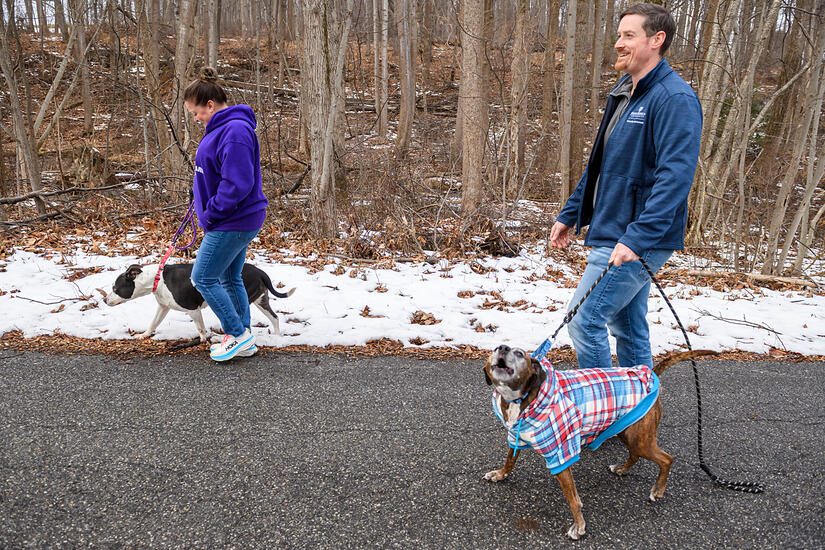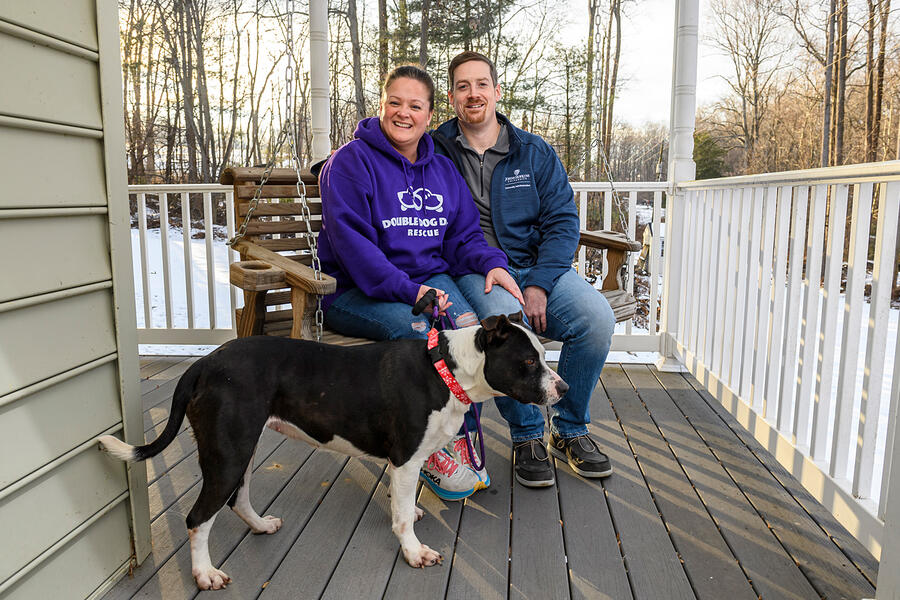My Other Life is an At Work series that lets us get to know our Johns Hopkins colleagues better. Do you or one of your co-workers have a personal passion that would make a good story? Let us know at hubatwork@jhu.edu.
Joel Searfoss can't imagine a home without dogs, even if they don't stay long. In fact, he hopes they won't stay long.
A brief stay means they've been adopted quickly by the perfect family—his goal for fostering them in the first place.
He takes in rescues and cares for them until they find forever homes, regardless of how long it takes. He, his significant other, Erica Klinedinst, and one of her children, Neveah (and their resident pup, Stubby) are passionate about helping these dogs, believing they get as much from doing so—maybe even more—than they give.
"We fall in love with all of them, and we've had some of the worst cases," he says. "Dogs that are skin and bones that were strays and neglected—and they still trust you even though humans have let them down. They are so forgiving. I have yet to have a dog that doesn't warm up, although it may take time. And to see them warm up and become loving, sweet dogs—there's nothing like it."
Searfoss is Johns Hopkins University's director of Benefits Compliance and Operations, which means he administers the employee benefits programs, including the 403(b) retirement saving plans and the support staff pension plans.
"My team and I are responsible for the day-to-day administration of the employee benefits, including making sure our vendors are providing the benefits in accordance with our plan terms and assisting our employees with accessing their benefits," he says. "A key component is ensuring that our plans remain compliant with the regulations that govern them, including annual audit filings and compliance mailings to employees."
He joined JHU in 2017 from Rite Aid Corp., where he spent more than 10 years in various roles, including that of senior benefits specialist and manager of retirement benefits.
He, Klinedinst, and her now 16-year-old daughter have taken in more than 60 dogs since they started in 2018, several years before losing Zoe, the first dog Searfoss had as an adult. "She's always with me," he says of the 11-year-old chocolate Labrador retriever. "I always think about her."
The middle son of three boys, "I grew up with Labs," he says. "We always had at least two dogs in the house, and they were always Labs. I went away to college but knew I wanted a chocolate Lab when I got my own place. There's something about the chocolates that melts my heart. They just get me."
Stubby isn't a chocolate Lab, or even a Lab. He's a Staffordshire terrier mix, a rescue who arrived from Texas in 2020, at first as a foster. He came with a small scar on his back left hip, its source unidentified, "but it might have been from barbed wire, or a cigarette burn" Searfoss says. "He was so sweet and gentle. We just fell in love with him."
Stubby was adopted but returned a week later "as he didn't work out in his new adopted home," Searfoss says. "During that week, we realized how much we missed him, and we were actually thrilled he was returned. I worked with the rescue to adopt him and surprised Erica with him for Valentine's Day that year. She had a special connection with Stubby and was overjoyed to have him join our family forever."
And they didn't care at all that Stubby wasn't a chocolate Lab.
"When you foster and see all the different types of dogs in need, you realize breed does not matter," he says. "All dogs have love to give. At the time, Stubby got along with Zoe and was just so affectionate toward the family. He also was great with the other fosters we had at the time and has been great to all since we adopted him."
The fosters come from Double Dare Dog Rescue, a small volunteer-based 501(c)(3) nonprofit in Westminster, Maryland, an organization that saves and finds homes for dogs of all breeds from numerous states.
"Each one has their own story in how they came to us and—after fostering more than 60 dogs—I would have never thought there would be one who wouldn't recuperate from whatever life has thrown at them," he says. "Every one of them has responded to our love and provided it back to us 10-fold."

Image caption: Klinedinst and Searfoss take a walk with Emma and a plaid-coated Stubby, who came to them as a foster in 2020.
Image credit: WILL KIRK / JOHNS HOPKINS UNIVERSITY
The household's guests have ranged from a 145-pound Great Dane to a hound dog who ultimately gave birth to six puppies in their home—although they usually care for one or two dogs at a time. The longest a dog has stayed was about 10 months, he says.
He remembers them all. There was Colby, for example, a black-and-tan coonhound from rural West Virginia who had been picked up by a local shelter as a stray in March 2020, just as COVID was shutting everything down, he recalls. Colby had to wait a month before traveling to Searfoss' home because he was seriously underweight, and the rescue team feared he wouldn't survive the transport.
"We knew we wanted to foster more than one dog," he says. "Within a week or two, we picked up Stubby and then Colby. Once we got Colby, we worked on getting his weight up and his just being an 'inside' dog. He had never actually been inside a house, which is not an uncommon occurrence we've come to find. Stubby and Colby got along like brothers."
That summer, Colby was adopted—but then returned. "However, just a few weeks later, the rescue was contacted by a couple from Ohio who had seen Colby's profile on its website," he says. "They drove over six hours to adopt him. They send us updates periodically, and Colby is living his best life. They even had him certified as a therapy dog, and he visits local hospitals and schools, helping those who are sick and or have special needs."
And there was the touching story of Tully the Rottweiler, a stray from Montgomery County, Maryland, that they began fostering just before Thanksgiving in 2022.
"Tully was the absolute sweetest dog you would ever want to meet and loved everyone and everything," Searfoss says. However, her medical examination found a serious and terminal heart condition, which made her unadoptable. He and Klinedinst kept her.
"So Tully became ours not knowing how much time we'd have with her, and we gave her the best life," he says. "Tully's spirit was never broken, and you would never have known she was ill. She was a goofy, happy-go-lucky dog up until we lost her in July 2023."
Searfoss keeps the fosters until they are adopted, and he has a say in approving every potential adoptive family.
"It's tough when they leave. You get attached to them all in some way," he says. "After my first foster was adopted, I was bawling my eyes out. The house felt so empty. We are just a safe place for them to trust humans again before they go where they are loved and needed. Getting updates on our fosters gives us the greatest joy, knowing they are safe and finally home."
Editor's note: The rescue community, Searfoss says, has seen a large influx of dogs since many people returned to their offices post-pandemic. Shelters are full, and resources are stretched thin. He encourages anyone interested in fostering, adopting, or donating money or supplies to visit the Double Dog Dare Rescue website.
Posted in News+Info
Tagged my other life









